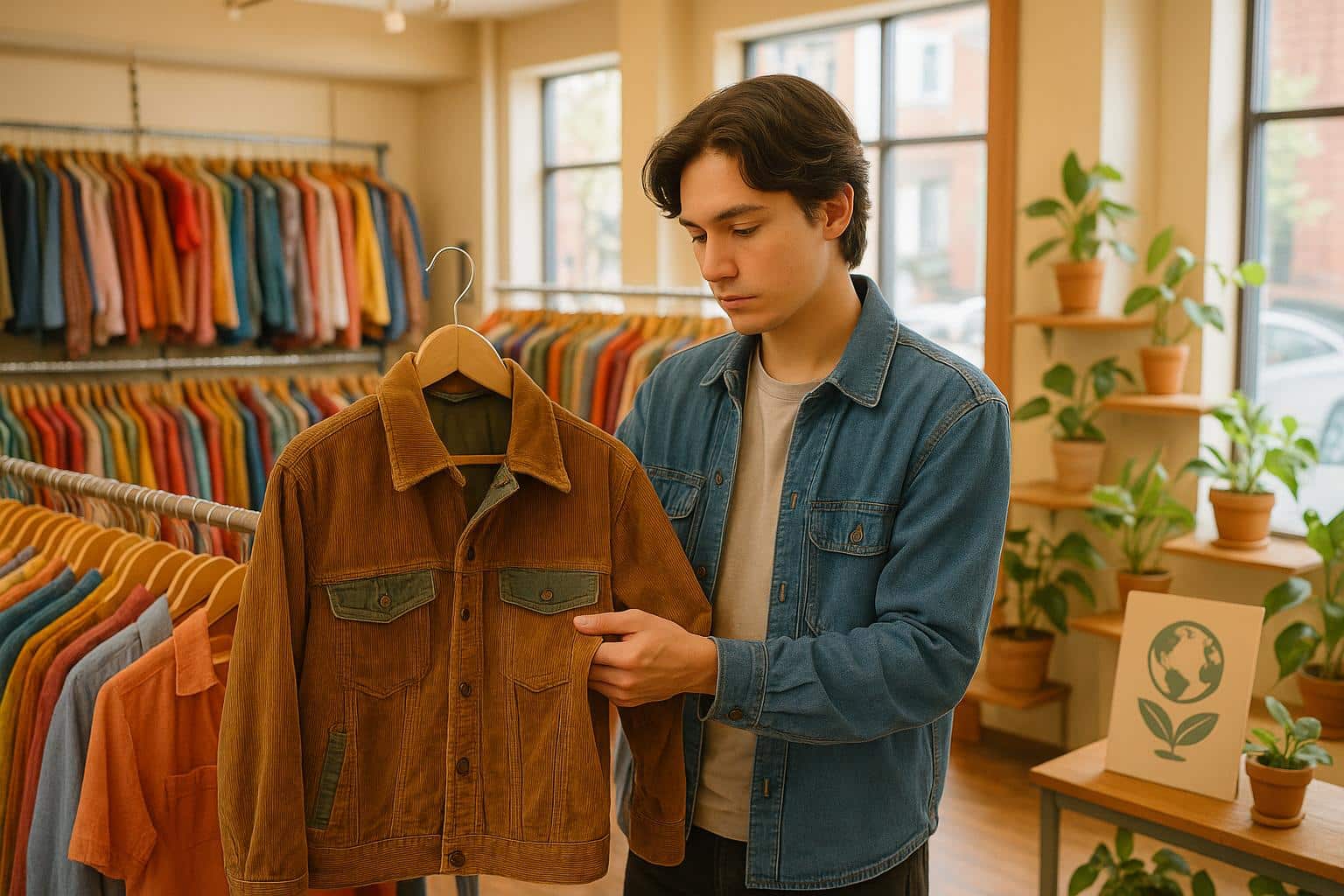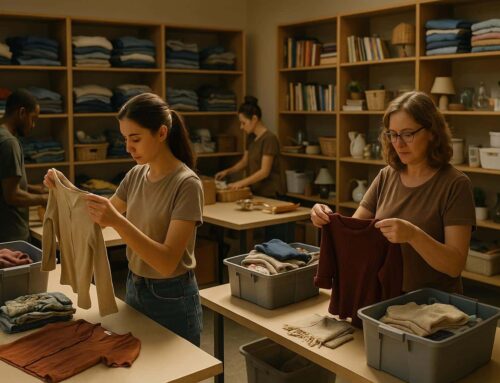Thrift shopping and fast fashion offer two very different approaches to clothing consumption, each with contrasting effects on the planet. Fast fashion prioritizes cheap, trendy clothing but drives waste, pollution, and resource depletion. In contrast, thrift shopping extends the life of garments, reduces waste, and conserves resources by reusing existing items.
Key Takeaways:
- Fast fashion contributes to 10% of global carbon emissions, consumes massive water resources (e.g., 700 gallons for one cotton shirt), and generates 92 million tons of textile waste annually.
- Thrift shopping avoids new production impacts, reduces carbon emissions by up to 90% for items like jeans, and saves billions of gallons of water by reusing clothing.
Quick Comparison:
| Factor | Fast Fashion | Thrift Shopping |
|---|---|---|
| Carbon Emissions | High (e.g., 2.50 kgCO2e per wear for jeans) | 90% lower emissions |
| Water Usage | 1,800 gallons per pair of jeans | No new water required |
| Textile Waste | 92 million tons/year | Clothing diverted from landfills |
| Resource Use | Heavy demand for new materials | Relies on existing resources |
Switching to thrift shopping not only helps reduce waste but also supports local communities through initiatives like City Thrift, which combines secondhand sales with charitable efforts. Every small change in shopping habits can make a big difference for the planet and society.
Fast Fashion: Impact on the Environment
Fast fashion has become a major environmental concern, creating a cascade of problems that affect ecosystems worldwide. Its focus on producing cheap, trendy clothing at breakneck speed has turned it into one of the most polluting industries on the planet.
High Carbon Emissions
Fast fashion is a significant contributor to greenhouse gas emissions, driven by its fast-paced production cycles and sprawling supply chains. Fashion production is responsible for about 10% of global carbon emissions, which is on par with the emissions of the entire European Union. If the industry continues on its current trajectory, emissions from textile manufacturing could increase by 60% by 2030, potentially reaching 2.8 billion tons of greenhouse gases annually. That’s equivalent to the emissions produced by over 550 million cars. Some projections even suggest that by 2050, the fashion industry could account for an alarming 26% of global carbon emissions.
The materials used in fast fashion add to the problem. For instance, producing a single polyester t-shirt emits 5.5 kg of CO₂, compared to 2.1 kg for a cotton t-shirt. Additionally, many manufacturing facilities in developing countries rely on coal-fired power, further increasing the carbon footprint.
“Fast fashion has a significant environmental impact. According to the UN Environment Programme, the industry is the second-biggest consumer of water and is responsible for about 10% of global carbon emissions – more than all international flights and maritime shipping combined.”– Rashmila Maiti, Global Commons, Earth.Org
Resource Depletion
The fast fashion industry is notorious for its excessive use of natural resources. It ranks as the second-largest consumer of water globally, with massive amounts needed for growing cotton and dyeing fabrics. For perspective, producing a single cotton shirt requires about 700 gallons of water, while a pair of jeans takes around 2,000 gallons. To grow just one kilogram of cotton, approximately 20,000 liters of water are used.
The environmental toll doesn’t stop there. Textile dyeing is a leading source of water pollution, responsible for roughly 20% of global clean water contamination due to the chemicals used in dyeing and finishing processes. The growing demand for fast fashion also leads to skyrocketing energy consumption, as brands today produce twice as many clothes as they did in 2000. This requires vast amounts of energy for manufacturing, transportation, and processing, with raw materials and finished garments often traveling thousands of miles, burning fossil fuels at every stage.
Textile Waste and Pollution
Fast fashion’s emphasis on disposable clothing has created a massive waste problem. Globally, people purchase around 80 billion new pieces of clothing annually, but the lifespan of these garments has plummeted. Over the past 15 years, the average number of times a garment is worn has dropped by about 36%.
In the United States, the problem is particularly severe. The average American throws away approximately 81.5 pounds of clothing each year. In 2018 alone, 17 million tons of textile waste ended up in U.S. landfills. Nationwide, about 11.3 million tons of textiles – or 85% of all discarded clothing – are sent to landfills annually. These textiles can take over 200 years to decompose, releasing greenhouse gases and harmful chemicals into the environment. Of the 100 billion garments produced globally each year, a staggering 92 million tons are discarded in landfills.
Another issue is microplastic pollution. Synthetic fabrics like polyester shed tiny plastic fibers during washing, which eventually make their way into oceans. Around 35% of all microplastics in the ocean come from laundering synthetic textiles. Each year, about 500,000 tons of microfibers are released into the ocean through washing clothes.
The economic losses are equally sobering. The lack of recycling and the routine disposal of unsold garments cost the industry $500 billion annually in lost value.
“Until brands tackle this issue first and foremost, ‘conscious collections’ by fast fashion brands can only ever be considered greenwashing.”– Flora Beverley, Co-founder of sustainable brand Leo’s Box
Thrift Shopping: Benefits for the Environment
Thrift shopping offers a meaningful way to counter the environmental toll of fast fashion. By extending the life of clothing and household items, it reduces waste, conserves resources, and cuts down on carbon emissions. Beyond finding unique styles and quality goods, shoppers contribute to a more sustainable future with every second-hand purchase.
Reducing Textile Waste
Over 17 million tons of textiles end up in U.S. landfills each year, where they can take centuries to break down. Thrift stores play a crucial role in addressing this issue by collecting donations, reselling items that still have utility, and recycling unsellable pieces. This approach fosters a circular economy, where products are reused instead of discarded, significantly cutting down on waste.
Conserving Resources
Second-hand shopping goes a long way in conserving resources by decreasing the need for new production. For instance, making a single cotton shirt requires over 700 gallons of water, while a pair of jeans demands around 7,500 liters. Opting for second-hand clothing can save billions of gallons of water annually if enough consumers make the switch. A simple thrifted outfit, costing about $15, can save approximately 4,457 gallons of water. Additionally, it reduces the environmental harm caused by pesticides and toxic dyes commonly used in manufacturing new clothes.
Lowering Carbon Footprint
The fashion industry accounts for roughly 10% of global carbon emissions, making it the second-largest industrial polluter worldwide. Buying second-hand items helps mitigate this impact, as these goods have already gone through the resource-heavy production process. On average, purchasing pre-owned clothing can reduce carbon emissions by 25% compared to buying new. Plus, reused items often require minimal transportation, further limiting fossil fuel use. Together, these actions lessen industrial emissions and ease the strain on natural resources.
Side-by-Side Comparison: Impact on the Environment
Fast fashion is notorious for its heavy use of resources and substantial waste production, while thrift shopping offers a way to extend the life of garments and reduce the demand for new materials. Here’s a closer look at how these two approaches stack up in terms of environmental impact.
Take jeans, for example. A single pair produced through fast fashion emits 2.50 kgCO2e per wear, but second-hand options can slash that footprint by up to 90%. Producing new jeans also requires an astonishing 1,800 gallons of water, a demand completely avoided when purchasing second-hand items.
Comparison Table
| Environmental Factor | Fast Fashion | Thrift Shopping |
|---|---|---|
| Carbon Emissions | 2.50 kgCO2e per wear for jeans | 90% lower carbon footprint |
| Water Usage | 1,800 gallons per pair of jeans | No additional water needed |
| Textile Waste | 92 million tons annually | Diverts clothing from landfills |
| Resource Consumption | High demand for new materials and chemicals | Relies on existing resources |
| Production Impact | Toxic chemicals and water pollution | No new production required |
| Disposal Rate | Over 81 pounds per American annually | Extends garment lifespan |
| Economic Model | Linear: produce, consume, dispose | Circular: reuse, extend, recycle |
Thrift shopping significantly reduces waste by keeping clothing out of landfills, helping to cut the 81 pounds of textile waste generated by the average American each year. In contrast, fast fashion continues to deplete resources and pollute ecosystems with toxic chemicals, excessive water use, and waste.
The global fashion industry is responsible for 8–10% of worldwide emissions and releases 1.2 billion tonnes of carbon annually. If current trends persist, emissions could climb to 2.8 billion tonnes annually by 2030. However, embracing second-hand shopping could shift this trajectory. By reducing carbon emissions by as much as 90%, thrift shopping offers a tangible way to lessen the environmental burden of fashion.
How Community Thrift Stores Help
Community thrift stores do more than just provide affordable shopping options – they create meaningful change for the environment and local communities. They combine sustainability efforts with support for charitable causes, making a significant impact on both fronts.
Promoting Reuse and Recycling
The U.S. generates an enormous amount of clothing waste every year, and City Thrift offers a practical solution. By giving donated items a second chance, they help reduce the staggering statistic that 84% of donated clothing ends up in landfills or incinerators. Every item donated to City Thrift either finds a new home through resale or is recycled, diverting waste from landfills and extending the life of usable goods. This simple yet effective process plays a crucial role in reducing waste and promoting a culture of reuse.
Supporting Charitable Causes
Community thrift stores like City Thrift are deeply rooted in supporting local charities. As a non-profit, City Thrift directs all proceeds to City Union Mission, funding programs that tackle homelessness and poverty in the Kansas City area. When shoppers make a purchase, they’re not just buying an item – they’re contributing to essential services like meals, shelter, and crisis assistance for those in need. This dual purpose of sustainable shopping and charitable giving strengthens community ties and provides critical support where it’s needed most.
Building Community Involvement
City Thrift thrives on community participation, inviting donations, volunteers, and financial contributions to keep their mission alive. Volunteers are the backbone of operations, helping with tasks like sorting donations, managing the store, and assisting customers. This hands-on involvement fosters a sense of ownership and connection among community members. Beyond the operations, these thrift stores become spaces where people can learn about sustainability and responsible consumption. Families and regular shoppers discover the benefits of secondhand shopping, helping to spread eco-conscious habits throughout the community.
With multiple locations across Kansas City and nearby areas, City Thrift makes it easy for people from all walks of life to participate. Every donation, purchase, and hour of volunteer work feeds into a larger purpose: creating a healthier environment and a stronger, more connected community network.
Conclusion
Choosing between thrift shopping and fast fashion isn’t just a personal decision – it’s a way to shape the future of our planet. While fast fashion drains resources and clogs landfills, thrift shopping provides a far more environmentally friendly option.
By opting for secondhand clothing, shoppers help keep garments out of landfills, reduce the demand for resource-heavy new production, and contribute to a cycle of reuse. This shift is reflected in the growing secondhand market. As Goodwill Industries International highlights:
“By choosing secondhand, people in Gen Z are making conscious decisions that align with their values, including fostering a culture that prioritizes community and sustainability over disposable trends.”
The numbers back this up. The U.S. secondhand clothing market is projected to hit $64 billion by 2024, showing how sustainable shopping is gaining traction. It’s not just about reducing waste – it’s also about finding unique, stylish options while making a tangible difference for the environment.
Community thrift stores are central to this movement. Stores like City Thrift take the benefits of secondhand shopping even further by combining environmental impact with social good. Every purchase at City Thrift not only keeps items out of landfills but also funds City Union Mission’s efforts to combat homelessness and poverty in the Kansas City area. It’s a simple yet powerful way to support both the planet and your local community.
Start by donating your unused items and shopping secondhand. Every purchase contributes to reducing waste and conserving resources, helping to shrink the fashion industry’s environmental footprint. With several City Thrift locations across Kansas City and nearby areas, making this change is easier than ever. Together, we can choose better for our planet and our communities.
FAQs
How does thrift shopping help reduce the environmental impact of the fashion industry?
Thrift shopping offers a practical way to lessen the environmental strain caused by the fashion industry. By buying pre-owned clothing and items, you extend their lifespan, reducing waste and conserving valuable resources like water, energy, and raw materials that are heavily used in new production.
Opting for second-hand goods also helps decrease carbon emissions tied to manufacturing and transportation. Plus, it keeps textiles from ending up in landfills. It’s an easy, everyday choice that allows you to make a positive difference for the planet while embracing more eco-conscious habits.
How does thrift shopping compare to fast fashion in terms of environmental impact?
Thrift shopping and fast fashion sit on opposite ends of the spectrum when it comes to their environmental impact. Fast fashion is notorious for its role in pollution, churning out massive amounts of textile waste, guzzling water and energy, and accounting for as much as 10% of global greenhouse gas emissions. Its rapid production cycles and throwaway culture put immense pressure on natural resources while contributing heavily to overflowing landfills.
On the flip side, thrift shopping offers a much greener alternative. By giving clothes and other items a second life, it reduces the need for new production, conserves valuable resources, and cuts down on waste. Opting for second-hand goods is an easy step toward a more eco-conscious lifestyle, helping to minimize pollution and promote reuse.
When you shop at community-driven thrift stores like City Thrift, you’re not just helping the environment – you’re also supporting local causes. These stores often channel their profits into critical programs addressing issues like homelessness and poverty. It’s a small choice that creates a ripple effect of positive change for both the planet and the people around you.
How do thrift stores like City Thrift help the environment and support local communities?
Thrift stores, such as City Thrift, serve a dual purpose that benefits both the planet and local communities. By offering second-hand items a chance at a new life, these stores help cut down on waste, conserve resources, and keep perfectly usable goods from ending up in landfills. It’s a small but impactful way to embrace a more eco-friendly lifestyle.
But there’s more to it than just being green. The proceeds from City Thrift go toward supporting local initiatives, including programs that tackle homelessness and poverty. Whether you’re shopping, donating, or volunteering, your actions not only benefit the environment but also make a meaningful difference in the lives of those in your community.






